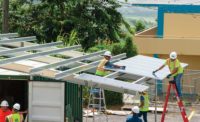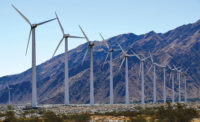Energy Viewpoint
A Case For Renewable Energy
Engineers and contractors can’t make good business decisions without making doubly certain that their data are good and their understanding of their market is clear-eyed and accurate. President Donald Trump’s ill-informed dismissal of the economics of the renewable-energy industry therefore is as disturbing as his ignorance of the economics of the fossil-fuel industry. Without evidence, he asserts that renewable energy is unreliable and too costly, and with equally weak justification, he thinks he can support natural-gas development and the revitalization of the coal industry simultaneously.
Just two weeks before the election that made him our president-elect, he asserted that clean-energy advocates “want everything to be wind and solar. Unfortunately, it’s not working on large-scale.” But Texas has installed more wind-generation capacity—18,531 MW with additional 5,040 under construction—than any other state, and Iowa currently is serving nearly 40% of its electrical load with wind energy. MidAmerican Energy is investing $3.6 billion in building 2000 MW of wind energy in Iowa and is ultimately aiming for 100% renewable energy production for its retail customers. That’s MidAmerican Energy, owned by Berkshire Hathaway Energy, the investment vehicle for Warren Buffett, a man not known for making foolish, uninformed investments.
OK, but what about solar? Trump said, “Solar is very, very expensive; wind is very, very expensive.” But a September 2016 Dept. of Energy report listed the price declines of onshore wind turbines (41%), rooftop solar (54%) and utility-scale solar farms (65%) since 2008. DOE’s SunShot Initiative, a national effort to drive down the cost of solar electricity and support solar adoption, was launched in 2011. To date, it has achieved the following reductions in the levelized cost of electricity (LCOE): Residential solar from 42¢/kilowatt-hour in 2008 to 18¢ in 2016; Commercial solar from 34¢ to 13¢; Utility solar from 27¢ to 7¢. By 2030, all are expected to cost 3¢-5¢/kWh. Now DOE has reported a tripling of utility-scale solar power since 2014. Our president appears to be working with old data.
But they are intermittent, right? You can’t rely on wind and solar round-the-clock. Except you can. Energy-storage technologies have advanced enormously in recent years. Landscape-altering pumped-hydro storage has been replaced by great banks of batteries; molten salt for concentrated solar power storage; and flywheels and other technologies of manageable size.
Trump also has repeated the canard about the Obama administration’s "war on coal" to justify his call to save the coal industry by liberating it from “job-killing regulations.” Those slogans make good bumper stickers, but lousy policy. Throughout the 20th century, coal-fired power plants were built and burned coal until they were decommissioned. In August 2008, for almost the first time in history, fuel-switching from coal to natural gas occurred. That was not repeated for some time, but in the last few years, fuel-switching and the complete retirement of coal plants in favor of natural gas and even of solar and wind has brought the coal industry to its knees. Because of regulatory burdens? No, because the price of natural gas has made that fuel more competitive than coal’s for electricity generation. Not coincidentally, 2008 was the year in which hydraulic fracturing of shale beds began to produce natural gas in such quantities that the fuel’s price declined precipitously. Gas and coal compete. No regulatory sleight of hand will enable both fuels to thrive.
The new administration is focused like a laser on job creation, and that’s why it aims to bring back coal-industry jobs. But capitalism is a system of creative destruction; when one sector is declining, it pays to remain alert because that sector’s market probably is being taken over by a competitor. That’s happening with the energy industry. For reasons both regulatory and economic, the coal industry is dying, as even one of its leaders says. The wind-energy industry is taking up the slack, growing 20% in 2015 to 88,000 jobs and expected to support 500,000 jobs by 2050. Solar, meanwhile, has already outstripped wind as a jobs generator. DOE’s Energy and Employment Report for 2017 says the solar workforce already is at 374,000.
If you want to check the links in this viewpoint, please do it quickly. DOE’s Office of Energy Efficiency and Renewable Energy may soon be shut down because our new president has made known his distaste for inconvenient facts. He prefers his alternative facts, so we may have no good data to work with when he’s done with his epic cleansing of the DOE. You will have to find other ways to keep your understanding of your market clear-eyed and accurate to survive. The evidence-based facts in this viewpoint may be a good place to start.
Tom Armistead is the consulting editor of ENR Energy. After a 23-year career in construction, he served 12 years as ENR’s editor, first for power and industrial news and subsequently for energy news.




